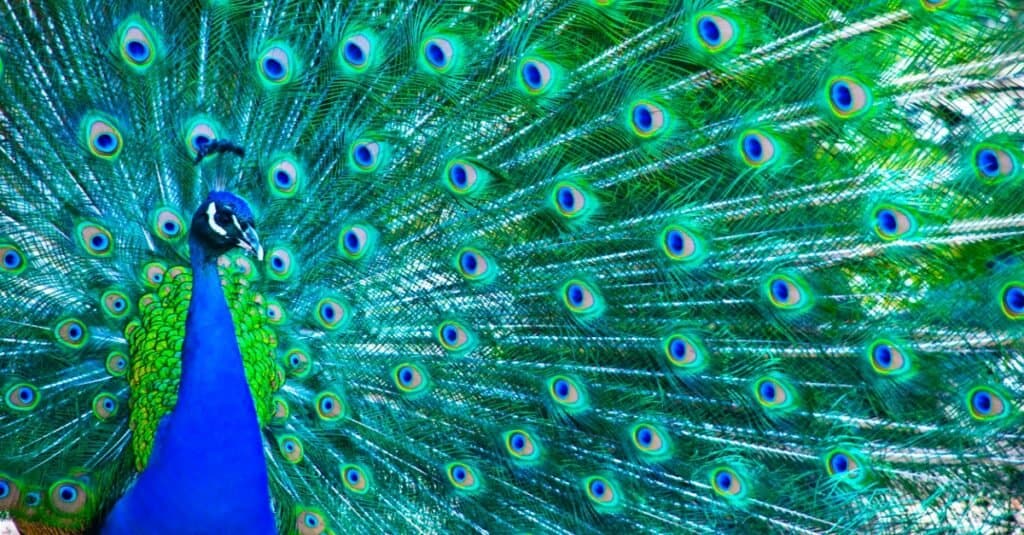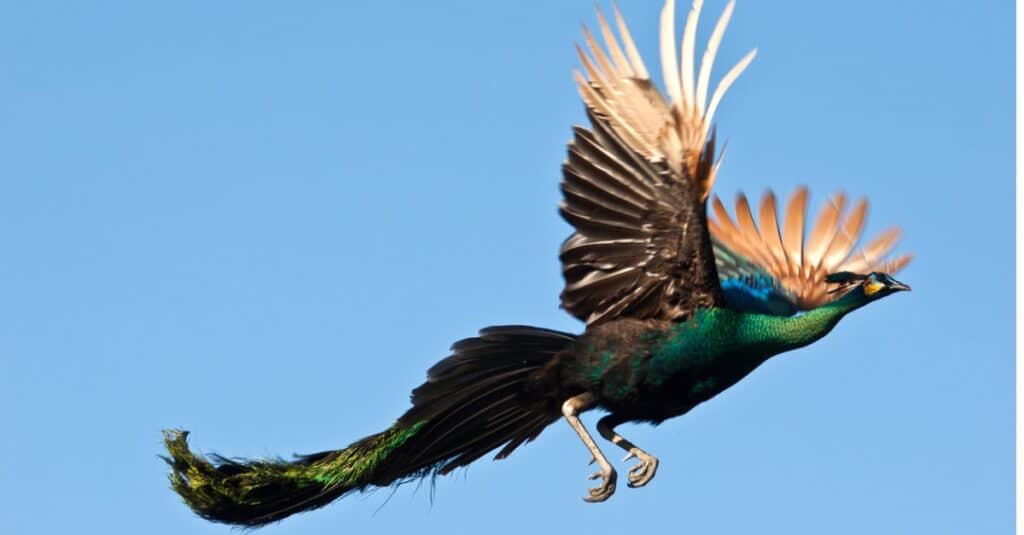There’s something about the peacock that draws the human imagination. Some of that curiosity surely comes down to the fact of how utterly impractical these birds seem. Despite their bulk of decorative feathers, peacocks can fly! The abundant and enormous tail feathers of the males are the most obvious draw, given the fact that their iridescent coloring and spots that lend the appearance of realistic eyes lend them an appearance bordering on the supernatural.
The term peafowl refers to three species of birds — the Congo, Indian, and green peafowl. Apart from some minor variations in coloring and size, each of these species is largely identical to one another, and each type of peacock can fly. While only males of the species possess the distinct tail feather covering, females still possess the bustle of feathers that follows them.
Everything about these birds — from their enormous tails to their awkward body shape to their irregular size — seems to suggest a species impractically built for self-defense against predators and poorly suited for flight. But the peacock has managed to survive, and its relationship with flight is more complicated than it might appear at first. If you want to know how far, how fast, and how long a peacock can fly, keep reading.
Why Do Some Birds Not Fly?

©iStock.com/AlexeyVis
Birds are distinguished most notably by their feathers, wings, and — to a lesser extent — hollow bones. All of these are features that were presumably developed to assist with flight. But evolution rarely takes the form of a straight line, and organisms naturally adapt to the specific — and often unusual — demands of their environment and both the predators and prey around them. Such is the case with dolphins — which evolved over generations into one of the most intelligent ocean creatures despite their ancestors walking on four legs 50 million years ago. From that perspective, the notion of birds that can’t fly is significantly less dramatic — but flightless birds are still relatively rare creatures.
In total, there are over 60 flightless bird species — but the largest grouping of these belongs to the rails family. Both the high number of listed rails species and their lack of flight can be related to their isolation. Most occupy very small islands with few mammalian predators. Flight has proven to be a very effective mechanism both for hunting and avoiding predation, but it’s also an incredibly inefficient use of an animal’s energy. In smaller habitats with less prey to choose from, flight is a liability rather than an asset.
Apart from rails, most flightless bird species are exceptionally large — although the most prominent flightless birds are of size many magnitudes larger than the peacock. Emus can weigh up to 120 pounds. Size is an evolutionary characteristic that scales inversely to flight. Being large reduces the number of natural predators that can potentially target you while requiring disproportionately higher energy demands for foraging or hunting. In environments where the flight was less ideal for survival, birds developed new modes of locomotion. That doesn’t mean that the wings simply become vestigial organs.
Ostriches have developed powerful legs that can be a gruesome defensive tool in addition to letting them reach running speeds of 50 miles per hour. Feathers help stabilize these rotund birds at high speeds, but they can also be extended like a parachute to help them break. Meanwhile, the flippers of the penguin have evolved to more resemble oars — a natural extension of the tool that suits birds who do their hunting underwater.
What Does Flight Mean For Birds?
How far, how long, and how fast a bird can fly is both the result of its environment and a reflection of how it impacts its environment. At what age a bird flies can tell you a significant amount about how it evolved. Because in the same way that ostriches and penguins have adapted their wings to suit different forms of mobility, flying birds have developed different methods of flight as their environment demands. The scientific community isn’t even entirely in agreement on how or why wings evolved in the first place, and that further complicates our understanding of what flight should even look like.
There are three hypotheses in current contention: that wings evolved as an extension of jumping with gliding as an intermediary process, that they developed to help stabilize the body while running on inclines, and that they developed from predators that pounced from trees onto their prey.
How long a bird can stay in flight doesn’t necessarily tell you much about its evolutionary effectiveness. Falcons use gravity to their advantage, and they’ve evolved wings that allow them to swoop downward at high speed so that they can snatch prey out of the air and return upward without barely a pause. Sea birds tend to have developed wings that allow them to soar actively without the need for flapping — an evolution that lets them spend much of their time over water without expending too much energy.
Size is a factor in why ostriches and emus don’t fly, but it’s not a mitigating factor for all birds. The wandering albatross has an incredible 12-foot wingspan, and they’re known for traveling years at a time without resting on solid land. It’s no coincidence that they’ve developed wings that maximize their ability to glide.
Can Peacocks Fly?

©iStock.com/Marina_Poushkina
Peacocks can fly, but they don’t employ that skill in quite the same way most of their avian peers do. The average peacock will only spend 2% of its time in flight — and they aren’t particularly graceful birds in flight either. As with most flightless birds, their specific sense of flight is tied to the particular circumstances of their environment. Unlike most flying birds, they use their wings neither to migrate nor to swoop down upon prey. Instead, flight has developed as a secondary navigation method, with their primary means of locomotion being their feet. Their talons let them achieve speeds of 15 miles per hour, and their claws can double as a brutal defense mechanism against predators.
It’s an evolution that makes sense when you consider that these birds are capable foragers. They’re closely related to pheasants, chickens, and turkeys — and their habits are rather similar as a result. Peacocks do their hunting and foraging on the ground and eat an omnivorous diet that can vary in size from berries, insects, and seeds to small mammals and lizards.
And while the train of feathers that follow them attracts plenty of predators, it can rip away without injuring the bird. Flight serves primarily as not a means of normal mobility but as a defense mechanism in its own right. Peacocks will use flight to launch themselves vertically into the air to roost. These birds will escape into the canopies of trees to actively elude predators and as a place to roost safely during the evening.
Peacocks have other defense mechanisms that prove effective as well. Peacocks will fan out their feathers to elude predators. When they do this, they appear much bigger than they actually are, which may spook a tiger or racoon. Their most vicious way to protect themselves is by kicking predators with sharp spurs that are attached to their feet. “Kicking thorns,” as it is called, will cut up a predator who gets too close. So, peacocks do not need to use their wings too often even when predators come for them.
How Far and High Can Peacocks Fly?
What qualifies as flight for the peacock would barely register as takeoff for most birds. When ascending into a roost, a peacock lets its legs do most of the work. A peacock will often start flight in a run and jump a few times to build up momentum before finally launching itself. By flapping their wings furiously, they can reach heights of around eight feet — roughly double their height. But the weight and design of peacocks don’t allow them to stay aloft for long. While they can gain a little distance from launching off of higher branches, the average peacock won’t clear a range of longer than about 300 feet. That’s significantly further than a chicken and comparable to a turkey.
How Fast Can Peacocks Fly?

©iStock.com/charti1
Since their flight is mostly vertical and lasts for only seconds at a time, it’s difficult to pinpoint an exact flight speed for a peacock. Fortunately, neither speed nor distance is an issue for peacocks. They only ever need to fly to ascend into and descend from their roosts and to occasionally clear obstacles. This is rarely an issue, like the environments, these birds live in to allow them to survive throughout the seasons without migrating. Despite peacocks possessing a tail that can stretch as long as six feet, these colorful tail feathers don’t seem to have a noticeable effect on how fast or how high a peacock can fly.
At What Age Do Peacocks Learn to Fly?
Peafowl chicks are typically doted upon by their mothers, who protect them against extreme temperatures by hugging chicks underneath their wings. But since flight is one of this bird’s primary defense mechanisms, learning is a priority. Chicks are physically capable of flying within a few days of birth, but learning the fundamentals can be a dangerous and time-intensive process. Mothers will usually encourage chicks to practice their flying skills during the evening, and they’ll begin to take lessons in running and foraging for food while under the care of their mother. What age a peacock becomes a competent flier can vary from chick to chick, but most will acquire the skills by the time their mother leaves them at about six months of age.
Up Next…
Now you know peacocks can technically fly. Here are some truly flightless birds.
- 10 Flightless Birds That Are Extinct Fossils reveal there are only 60 flightless bird species alive today. Check out 10 that didn’t make it.
- 10 Birds That Can’t Fly A bird is a bird because it has wings and can fly, right? Wrong!
- 10 Incredible Ostrich Facts Learn about these flightless birds with super fast and powerful legs.
The photo featured at the top of this post is © iStock.com/Anna_Brothankova
Thank you for reading! Have some feedback for us? Contact the AZ Animals editorial team.






